I will get skin cancer!” my senior would exclaim dramatically every time we stepped out into the sun. Without missing a beat, she’d dig into her bag, whip out a sunscreen bottle, and start applying it as if her life depended on it.
To be fair, her fear wasn’t irrational. Years of research have linked excessive sun exposure to skin cancer, photoaging, and sunburns.
But in a surprising twist, a new debate is sizzling in the skincare world: Is sunscreen itself a carcinogen? Could the very thing we use to protect our skin be harming us? Let’s break it down.
What Part of Sunlight Is Harmful?
Sunlight consists of three main components:
- Visible light – What we see
- Infrared radiation – What we feel as heat
- Ultraviolet (UV) radiation – The sneaky culprit behind skin damage
UV light is further divided into:
- UVA – The longest wavelength, penetrates deeper into the skin, accelerates aging, and contributes to DNA damage.
- UVB – Causes sunburns and is directly responsible for mutations that lead to skin cancer.
- UVC – The shortest but mostly absorbed by the ozone layer (thankfully!).
UV Radiation and Skin Cancer – The Real Culprit
Research confirms that UVA and UVB are the real troublemakers. UVB directly triggers mutations in DNA, while UVA indirectly damages skin cells by generating free radicals. Both contribute to skin cancer, making sun protection non-negotiable.
According to the Journal of Investigative Dermatology, Thomas M. Runger explains how different wavelengths of the ultraviolet spectrum contribute to skin carcinogenesis and their role in cellular damage responses.
Organic vs. Inorganic Sunscreens
Sunscreens come in two main categories:
- Organic (Chemical) Sunscreens
- Absorb UV rays and convert them into heat.
- Contain aromatic compounds but may cause allergic reactions.
- Inorganic (Mineral) Sunscreens
- Contain zinc oxide (ZnO) or titanium dioxide (TiO₂), which sit on the skin and scatter UV rays.
- Less likely to cause allergies but can leave a white cast.
Which One Is Better?
Both types are effective, but inorganic sunscreens have a lower risk of causing skin irritation. Some chemical sunscreens, such as oxybenzone, have raised concerns, but research suggests they are safe at regulated levels.
A study conducted by a group of researchers in 2020 found that certain sunscreen ingredients are absorbed into the bloodstream, but no evidence suggests they cause harm at approved levels.
How Much SPF Do You Need?
When buying sunscreen, SPF (Sun Protection Factor) is the first thing we check. But do higher numbers really mean better protection?
- SPF 15 – Blocks ~93% of UVB rays
- SPF 30 – Blocks ~97% of UVB rays
- SPF 50 – Blocks ~98% of UVB rays
Higher SPF offers slightly better protection, but real-world factors like sweating, rubbing, and incomplete application reduce effectiveness.
Dermatologists recommend SPF 30+ with broad-spectrum protection (UVA + UVB) and reapplication every two hours.
According to the Skin Cancer Foundation, daily sunscreen use (SPF 15 or higher) reduces the risk of developing melanoma by 50%.
Are There Any Risks with Sunscreens?
Some concerns have been raised about sunscreen ingredients, including:
- Environmental impact – Certain ingredients contribute to coral reef destruction and bioaccumulate in marine life.
- Hormonal effects – Some studies suggest chemical sunscreens might interfere with hormones, but research is inconclusive.
- Skin penetration – Ingredients like oxybenzone can be absorbed into the bloodstream, but current research deems them safe at regulated levels.
Does This Mean Sunscreen Is Harmful?
No. The overwhelming consensus remains: The benefits of sunscreen far outweigh the risks. Studies confirm that regular use can reduce the risk of squamous cell and melanoma skin cancers.
In 2020, the Canadian Dermatology Association recommended using an adequate dose of broad-spectrum sunscreen as the best photoprotection strategy.
The Bottom Line: Love Your Skin, Use Sunscreen
So, should you fear sunscreen? No. Should you fear the sun? Also no.
The key is smart protection:
✔ Use broad-spectrum sunscreen (UVA + UVB).
✔ Wear protective clothing (hats, sunglasses, long sleeves).
✔ Seek shade during peak hours (10 AM – 4 PM).
✔ Reapply sunscreen every two hours for maximum protection.
And if someone reminds you to apply sunscreen, take it as a sign of love. Because nothing says “I care about you” like preventing wrinkles and skin cancer.
Stay sun-safe and glow responsibly! ☀💛
Written by – Tanvi Mongia
Edited by – Dr. Reshma Patil



